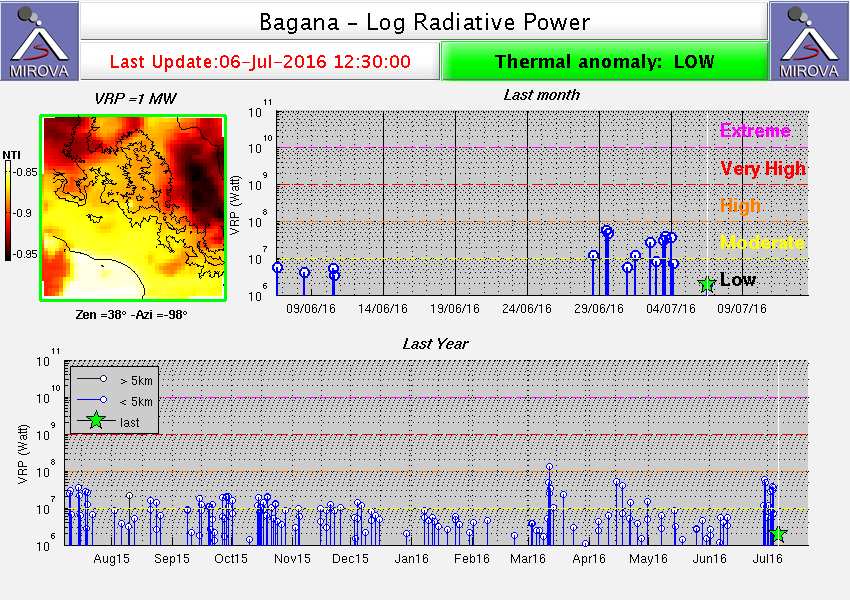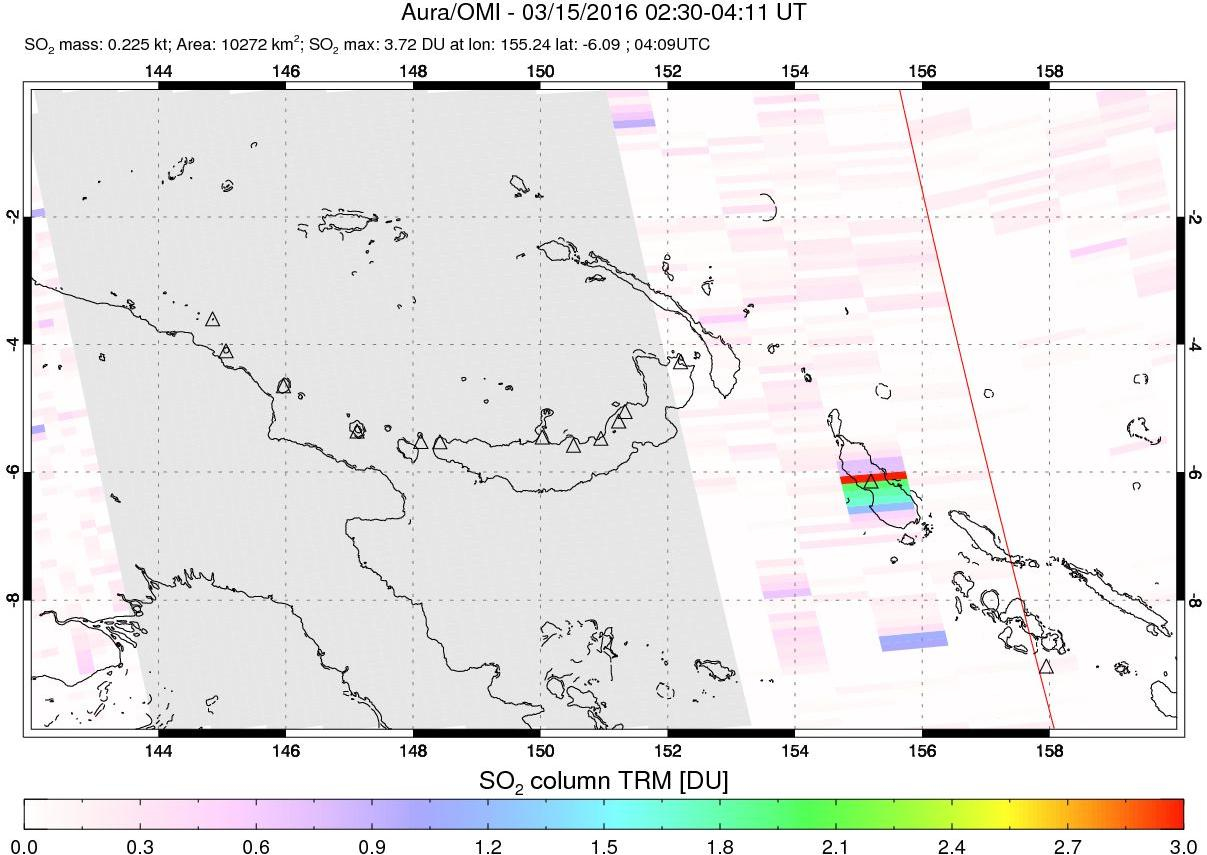Report on Bagana (Papua New Guinea) — July 2016
Bulletin of the Global Volcanism Network, vol. 41, no. 7 (July 2016)
Managing Editor: Edward Venzke.
Edited by A. Elizabeth Crafford.
Bagana (Papua New Guinea) Regular ash plumes and intermittent thermal anomalies during January-June 2016
Please cite this report as:
Global Volcanism Program, 2016. Report on Bagana (Papua New Guinea) (Crafford, A.E., and Venzke, E., eds.). Bulletin of the Global Volcanism Network, 41:7. Smithsonian Institution. https://doi.org/10.5479/si.GVP.BGVN201607-255020
Bagana
Papua New Guinea
6.137°S, 155.196°E; summit elev. 1855 m
All times are local (unless otherwise noted)
Volcanic activity at Bagana for the first half of 2016 was characterized by intermittent ash emissions and thermal anomalies similar to 2015. Evidence comes from the Darwin VAAC (Volcanic Ash Advisory Center) and MODIS infrared satellite data as processed by both MODVOLC (Moderate Resolution Imaging Spectroradiometer) and MIROVA (Middle InfraRed Observation of Volcanic Activity) , and OMI (Ozone Monitoring Instrument) SO2 data. No ground observations were reported during this time. The intermittent yet continuous nature of the eruption is best seen in the MIROVA data (figure 18).
MODVOLC only recorded single-pixel anomalies twice in January (7 and 23) near the summit on the north side. MIROVA (figure 18) also shows anomalies, likely on the same days in January and several other days in January and February, at levels consistently below 107 Watts VRP, indicating that Volcanic Radiative Power (VRP) was low but at detectable in January and February.
Darwin VAAC issued reports on ash plumes three times in March (3-4, 11, and 24). During 3-4 and 11 March, the plumes rose to 2.1 km and drifted 40-110 km N, NE and SE. A higher plume on 24 March rose to 3.6 km and was observed and modeled drifting 45-55 km NE and ENE. Additionally, the 11 March event was captured by MODVOLC as three pixels N and W of the summit. A small SO2 anomaly on 15 March was observed by the OMI instrument (figure 19); it quickly dissipated to the ESE within 48 hours. Another MODVOLC anomaly on 18 March of two pixels appeared a short distance NNE of the summit.
MODVOLC thermal anomalies of one or two pixels appeared three times in April (14, 17, and 21), all without corresponding Darwin VAAC reports. They were located slightly N, NE, and NW of the summit. Darwin VAAC reported two separate plume events later in April and early May. During 23-24 April a plume was observed at 2.1-3 km altitude drifting 25-35 km S and SW. An extended report of plumes from 26 April to 5 May by Darwin VAAC likely correlate with the MIROVA VRP spikes during that period (figure 18). These plumes rose to 2.1 km and drifted 45-100 km SW, W, and NW. The plumes were "clearly observed" by Darwin VAAC during this interval in visible satellite imagery on 26 and 28 April and 3 and 4 May.
Six more series of Darwin VAAC reports of ash plumes between 7 May and 16 June indicate continued activity. All plume heights were recorded as 2.1 km and drift distances were up to 140 km in various directions. Four of the report series only lasted up to 36 hours (7-8 May, 22 May, 2 June, and 16 June), but two of the report series covered longer periods of plume activity (25-29 May, 8-12 June).
Geological Summary. Bagana volcano, in a remote portion of central Bougainville Island, is frequently active. This massive symmetrical cone was largely constructed by an accumulation of viscous andesitic lava flows. The entire edifice could have been constructed in about 300 years at its present rate of lava production. Eruptive activity is characterized by non-explosive effusion of viscous lava that maintains a small lava dome in the summit crater, although occasional explosive activity produces pyroclastic flows. Lava flows with tongue-shaped lobes up to 50 m thick and prominent levees descend the flanks on all sides.
Information Contacts: Darwin Volcanic Ash Advisory Centre (VAAC), Bureau of Meteorology, Northern Territory Regional Office, PO Box 40050, Casuarina, NT 0811, Australia (URL: http://www.bom.gov.au/info/vaac/); MIROVA, a collaborative project between the Universities of Turin and Florence (Italy) supported by the Centre for Volcanic Risk of the Italian Civil Protection Department (URL: http://www.mirovaweb.it/); Hawai'i Institute of Geophysics and Planetology (HIGP), MODVOLC Thermal Alerts System, School of Ocean and Earth Science and Technology (SOEST), Univ. of Hawai'i, 2525 Correa Road, Honolulu, HI 96822, USA (URL: http://modis.higp.hawaii.edu/); OMI (Ozone Monitoring Instrument), Global Sulfur Dioxide Monitoring, Atmospheric Chemistry & Dynamics, NASA Goddard Space Flight Center, Goddard, Maryland, USA (URL: https://so2.gsfc.nasa.gov/)



